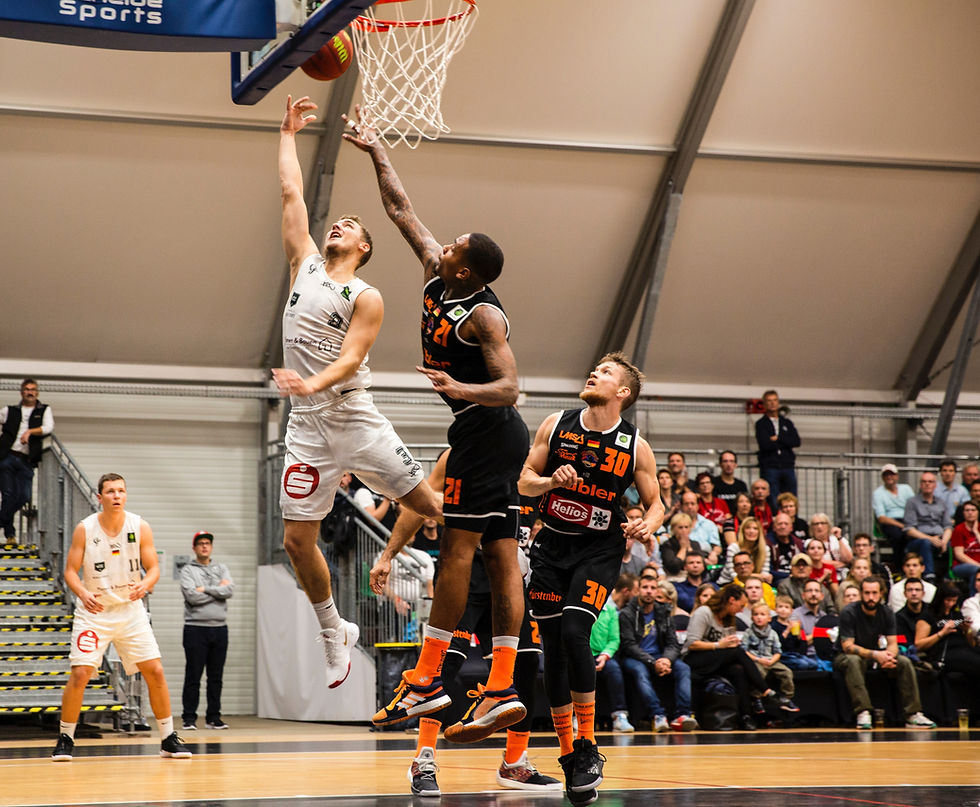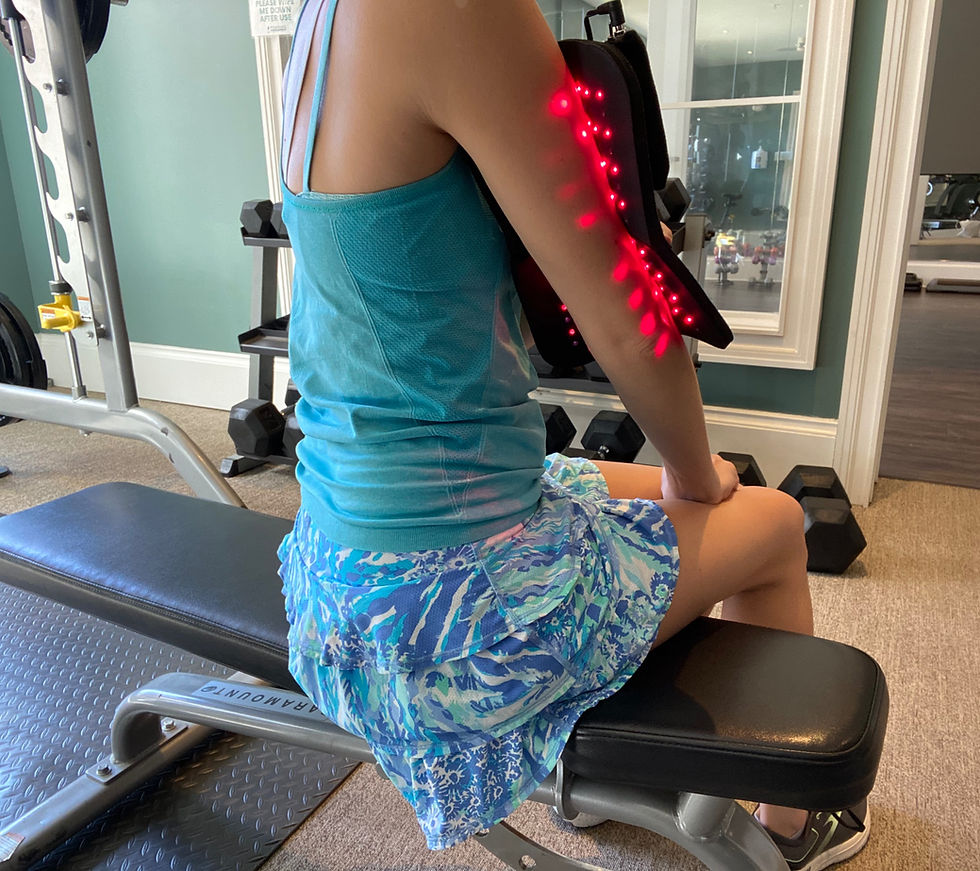Exercise Recovery with Red Light Therapy
- stephanie pope

- May 15, 2023
- 9 min read
Updated: Dec 15, 2023

Are you tired of feeling sore and stiff after a workout? Have you been looking for ways to speed up your recovery time and get back to training faster? If so, you may have heard about red light therapy. This non-invasive therapy has been famous for the past decade as it helps improve athletic performance and speed up recovery times.
Red light therapy has gained popularity as a potential tool to aid in exercise recovery. The therapy can be used to reduce muscle soreness, improve athletic performance, and promote faster recovery after intense exercise.
In this article, we will explore red light therapy, how it works, and its role in exercise recovery.
Understanding Red Light Therapy
Red light therapy is a type of light therapy that uses specific wavelengths of light to penetrate the skin and promote healing in the body. It's a non-invasive technique that has been used to improve skin conditions, promote tissue repair, reduce pain and increase blood circulation. These attributes help muscle tissue repair quickly and reduce the feeling of sore muscles.
Red light therapy is often used in conjunction with near-infrared light therapy, which uses different wavelengths of light that penetrate deeper into the body. Near-infrared light therapy has also been shown to improve muscle recovery, reduce pain and inflammation, making it an ideal treatment for athletes.
How Does Red Light Therapy Work?
Red light therapy is a non-invasive form of therapy that uses low-level red and near-infrared light (660-850nm) to stimulate cellular activity in the body. The red and near-infrared light penetrate the skin and stimulate the production of ATP (adenosine triphosphate) in the mitochondria, which is the primary source of energy for cells. The light energy can also be absorbed by the mitochondria for use. This increased energy production can lead to a range of therapeutic benefits:
Improved circulation - When blood flow increases, the amount of nutrients and oxygen delivered to the tissues also increases.
Improved lymphatic drainage - Light therapy can stimulate lymph drainage. This helps the body rid itself of lactic acid.
Reduced inflammation - When blood flow increases, the inflammation is pulled away from the area.
Increased collagen production - Light stimulation can help increase collagen production for tissue repair, joints, and skin flexibility.
Increased endorphin release - Light stimulation also encourages the body to release the natural pain reliever, endorphin hormones.

Red Light Therapy for Exercise Recovery
Red light therapy has been shown to have numerous benefits for exercise recovery. It is important to note that red light therapy is an excellent complementary recovery option. It is beneficial to use red light therapy along with other recovery methods: rest, nutrition, protein, hydration, active recovery, flexibility recovery and listening to your body.
Here are some of the ways in which red light therapy can help support the body recovering from exercise:
Reduces Muscle Soreness and Inflammation
Muscle soreness and inflammation are common after a workout, especially if you have pushed yourself. Intense exercise can cause inflammation in the body and lactic acid build up, which can lead to sore muscles and decreased athletic performance.

Thanks to red light therapy, reducing muscle soreness and inflammation is easy. The inflammation in the muscles and tissues can be reduced by increasing circulation and promoting the production of anti-inflammatory cytokines. The increased blood flow boosts the affected area with more oxygen and nutrients for a quicker healing process. It will also alleviate the associated pain, swelling and discomfort and allow for faster recovery.
Speeds Up Muscle Recovery
Muscle recovery is important to all athletes and red light therapy is great to stimulate the mitochondria within cells to produce more ATP (ATP is the primary source of energy for cellular processes). By increasing ATP production, red light therapy can enhance the energy available for tissue repair and regeneration, thereby accelerating the recovery process.
Red light therapy also stimulates the production of collagen, a protein essential for tissue repair and regeneration. Collagen provides structural support and promotes the healing of damaged tissues, such as muscles or tendons. By increasing collagen synthesis, red light therapy can aid in the recovery of injured or strained muscles.
Increased Blood Circulation
One of the benefits of red light therapy is helping the body release nitric oxide, a molecule that helps to relax and dilate blood vessels. This vasodilation can enhance blood flow and improve circulation throughout the body. Improved blood circulation delivers oxygen and nutrients more efficiently to tissues and organs, promoting their overall health and function. This increased supply of essential resources can promote healing and speed up the recovery process.

Additionally, red light therapy can stimulate the production of new capillaries, the smallest blood vessels in the body. The growth of new capillaries, called angiogenesis, can further enhance blood flow and contribute to improved circulation and removal of waste products such as carbon dioxide and lactic acid.
Reducing Pain
Whether you are experiencing muscle soreness or injury pain, red light therapy will help. It has analgesic properties, meaning it can help to reduce pain and discomfort associated with exercise-induced muscle soreness or injuries. It can also stimulate the body to release endorphins, the natural pain relief hormone.
By alleviating pain, red light therapy can improve mobility and allow individuals to resume their normal activities sooner, facilitating faster recovery.
Improves Range of Motion

Range of motion is an important factor in exercise. As mentioned above, red light therapy can help reduce soreness, inflammation and pain. Because of this, athletes range of motion increases and they can get back out there quicker.
Incorporating mobility exercises, stretching, and foam rolling into your routine can also enhance recovery by improving flexibility, range of motion, and reducing muscle tension.
Increases Endurance
Red light therapy has been shown to increase endurance by improving energy production in cells (ATP). This increased energy production can help to delay the onset of fatigue during exercise, allowing you to exercise for longer periods of time.
This can help improve muscle endurance and reduce muscle fatigue. One study found that athletes who received red light therapy experienced less muscle fatigue and were able to perform at a higher level than those who did not receive the therapy.
Enhances Muscle Strength

After strength training, athletes aim to rebuild muscle tissues with protein. Red light therapy, along with proper nutrition, can enhance muscle strength by promoting the growth of new muscle cells and tissues. With stronger muscles, risk of injury is reduced and performance is increased.
Injury Recovery
It's important to have a good injury recovery plan. Rest from exercise will be key to helping your body recover and help avoid further damage. Using red light therapy to support the healing process will also be very beneficial. As mentioned above, it can help reduce inflammation and pain, increase blood circulation and repair injured tissues. With these benefits, it's easy to see how red light can help during the injury recovery process.
Red light therapy has also been found to reduce the appearance of scars. Even old scar tissue can be broken down when applying red light daily. This is beneficial for scar tissue that restricts movement. When breaking down this scar tissue, better movement can be achieved.
Improved Sleep
Red light therapy has shown potential benefits for improving sleep quality and regulating the sleep-wake cycle, also known as the circadian rhythm. It can help align the body's internal clock, known as the circadian rhythm, with external cues like natural sunlight. Exposure to red light in the morning or during the day can help reset the circadian rhythm, promoting wakefulness and alertness during the day and supporting better sleep at night.

It can also influence the production of melatonin, a hormone that plays a crucial role in sleep regulation. Exposure to red light in the evening or before bedtime has been shown to support the production of melatonin, which can help shift the body into a relaxed state. The red color has a calming effect on the body and can promote relaxation. By reducing stress and anxiety levels, it can contribute to better sleep quality and faster sleep onset.
Additionally, adopting good sleep hygiene practices, such as maintaining a consistent sleep schedule, creating a relaxing sleep environment, and avoiding stimulating activities before bed, can complement the benefits of red light therapy for improved sleep.
When to Use Red Light Therapy for Exercise Recovery
Red light therapy can be beneficial for exercise recovery in a variety of situations. Here are some instances when using red light therapy for exercise recovery may be appropriate:

Post-Workout Soreness: If you experience muscle soreness or stiffness after exercising, red light therapy may help reduce inflammation and promote muscle recovery.
Injury Rehabilitation: If you have a sports injury, red light therapy may aid in the healing process by increasing circulation and reducing inflammation.
Pre-Workout Preparation: Some athletes use red light therapy before exercising to enhance blood flow and oxygen delivery to their muscles, which can improve performance and reduce the risk of injury.
Travel and Jet Lag: Long periods of travel can take a toll on the body, causing fatigue, muscle soreness, and disrupted sleep. Red light therapy may help reduce these symptoms and promote faster recovery.
Chronic Pain: If you suffer from chronic pain, red light therapy may be an effective non-invasive treatment option that can help alleviate pain and promote healing
Best Exercise Recovery Practices
Exercise recovery consists of various activities and practices that help the body and mind recuperate and restore themselves after physical exertion. Here are some essential components of exercise recovery:
Rest: Adequate rest is crucial for recovery. Allow your body time to recover and repair itself through sleep and periods of relaxation.
Hydration: Proper hydration is essential for replenishing fluids lost during exercise. Drink water or electrolyte-rich fluids to rehydrate and support optimal recovery.
Nutrition: Consume a balanced diet that includes a combination of carbohydrates, proteins, and healthy fats. Nutrient-dense foods provide the necessary fuel and building blocks for muscle repair and growth.
Stretching: Engage in stretching exercises to improve flexibility, release muscle tension, and promote blood circulation. Stretching can also help reduce post-exercise soreness.
Foam rolling: Use a foam roller or other self-myofascial release tools to apply pressure to tight or sore muscles. This can help alleviate muscle knots, increase blood flow, and enhance recovery.
Active recovery: Engage in low-intensity activities such as walking, swimming, or light cycling to promote blood circulation, reduce muscle soreness, and facilitate recovery without excessive strain on the body.
Massage or bodywork: Consider incorporating professional massages or other bodywork techniques like acupuncture or chiropractic adjustments to relieve muscle tension, enhance circulation, and aid in recovery.
Cold or hot therapy: Alternating between cold and hot treatments, such as ice baths or hot showers, can help reduce inflammation and promote muscle recovery. Cold therapy is beneficial immediately after exercise, while heat therapy can be applied later to relax and soothe muscles.
Red light therapy: Red light therapy, also known as low-level laser therapy, uses specific wavelengths of red light to promote cellular regeneration, reduce inflammation, and enhance tissue recovery. It can be used as part of an exercise recovery routine.
Gradual progression: Allow your body time to adapt and avoid overtraining. Gradually increase the intensity, duration, or frequency of your workouts to prevent injury and promote long-term sustainable progress.
Remember, the specific components and duration of exercise recovery can vary depending on factors such as the intensity of your workouts, individual fitness levels, and personal goals. It's important to listen to your body and adjust your recovery routine accordingly.
How to Use Red Light Therapy in Exercise Recovery
To incorporate red light therapy into your exercise recovery routine, follow these steps:

Choose the right device: Our high-quality red light therapy device emits wavelengths between 630 to 660 nanometers (nm) for optimal results.
Timing and frequency: Use red light therapy after your workout or physical activity. Aim for sessions of 20 to 30 minutes per targeted area. You can apply our red light devices up to 3 times a day for healing or 2 to 3 times per week for maintenance.
Cleanse your skin: Ensure the targeted area is clean and free of any lotions, oils, or clothing that could obstruct the light.

Positioning: Position the red light therapy device on the targeted area. Our LED devices are safe to lay directly on the skin.
Start the session: Turn on the red light therapy device and expose the targeted area to the red light. Relax and allow the light to penetrate your skin. You may choose to close your eyes or listen to calming music during the session.
Move the device: If you are treating multiple areas, reposition the device accordingly, ensuring each area receives equal exposure.
Be consistent: Incorporate red light therapy consistently into your exercise recovery routine to experience the potential benefits over time.
Precautions and Risks of Red Light Therapy
While red light therapy is generally considered safe, there are still some precautions and potential risks to keep in mind.
Skin Sensitivity
Some people may have a sensitivity to red light, and their skin may react negatively to the treatment. Before undergoing red light therapy, it's essential to consult with a healthcare professional or a dermatologist to determine if the treatment is suitable for your skin type.
Medical Conditions
People with certain medical conditions should avoid red light therapy. For example, those with lupus, epilepsy, or sensitivity to light may experience adverse reactions to the treatment. Pregnant women should also avoid red light therapy, as the effects of the treatment on a developing fetus are not yet known.
Interference with Medications
Red light therapy may interfere with certain medications or topical treatments, such as those used to treat acne. Before using red light therapy, it's important to consult with your healthcare provider to ensure that it won't interfere with any medications or treatments you're currently using.
Conclusion
Red light therapy is a safe and effective way to promote exercise recovery and improve performance. Whether you are an athlete or simply looking to recover faster from your workouts, red light therapy may be worth considering. With its many benefits and a few drawbacks, it is a promising new approach to exercise recovery that is sure to gain more attention in the years to come.

#exerciserecovery #redlighttherapy #exercise #exercisehealth #healthy #exerciserecoveryroutine #redlighttherapydevice #exercisewithfriends #run #strengthtraining #basketball #sports #runner #legday #coreworkout #workout #workouts #workoutrecovery #healing #injuryrecovery #redlightforrecovery #lighttherapy #lightwork #gym #gymbod #body #health #recovery #rest #restrunrepeat



